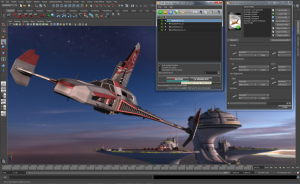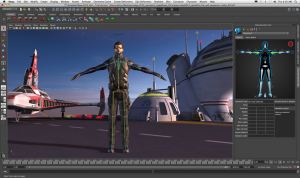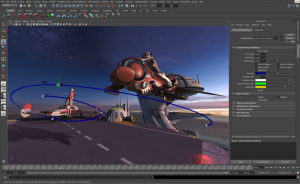By Mike de la Flor
Maya 2012 will be a favorite update for serious animators because many of the key upgrades are in the animation, character rigging, and dynamics workflows. However, other parts of Maya also received important improvements such as the Edit Mesh workflow and support for vector displacement as well as Per-face texturing, among many other importance improvements.
Awesome Animation
Maya is without a doubt the best animation suite available, and this release keeps Maya on top with key animation enhancements. Having made that assertion, the first item reviewed here is Editable Motion Trails, a type of tool that has been part of many other animation suites for years, but lacking in Maya – until now.
By projecting a visual representation of an animated object’s trajectory in the scene Editable Motion Trails allow animators to interactively adjust the shape of an object’s path in real time. Editable Motion Trails can also display keyframes so that timing and weighting (without the graph editor) can be accomplished with immediate feedback. Overall, using Editable Motion Trails is a simpler, faster way to edit animation paths.The Camera Sequencer, which made its debut Maya 2011, is an important tool for film and video editors/directors. The Camera Sequencer can import EDLs and all associated assets such as audio to better integrate animation with the video editing process. In Maya 2012 the Camera Sequencer features a new Shot Playlist for quicker access to camera settings and more efficient camera management. However, the coolest thing about the updated Camera Sequencer is the Ubercam. The Ubercam can bake data from many scene cameras onto one main camera for environments, like game engines, that cannot use multiple cameras. The Camera Sequencer is like having a little of After Effects or Final Cut in Maya.

Craft Animation provides two car and airplane rigs ready to mate with any model for straightforward realistic animation.
Maya 2012 includes the powerful Craft Animations plug-in, providing animators with two pre-rigged car and airplane proxy models. In general the Craft plug-in makes the difficult task of animating the natural motion of cars or airplanes simpler. For example, to animate a car, the car model is mated with the Craft car rig and the car can be “driven” via custom inputs like a joystick to produce the animation, which is recorded as keys. Also available are Craft camera rigs such as the SoftMotionCam and ObserverCam.In Maya 2012 the character rigging workflow is vastly improved with the Characterization tool, giving animators an intuitive rigging system that provides feedback to quickly and accurately map a skeleton to a Human IK rig. And the new Character Controls window provides a visual interface for managing IK and FK effectors on control rigs. In an ongoing effort to unify the look, usability, and data exchange between its applications Autodesk has made the Human IK system in Maya consistent with Motionbuilder.
Since Maya 8.5 the Nucleus Unified Simulation Network has been continuously developed by Autodesk into one best dynamics simulation packages available. nCloth was the first module released with subsequent modules following in later versions. In Maya 2012 many of the improvements to Nucleus are under the hood, including multi-threading for better performance. Nonetheless, the nDynamics Fluid Effects module features new attributes like Liquid Min Density and Tension Force among many other enhancements to produce physically accurate and realistic fluid simulations. The nCloth solvers have also been updated with new Rigidity and Deform Resistance to simulate rigid objects. The best thing about Nucleus is its ease of use, but to get the most out the solvers a hefty workstation is required.

The new Effects Assets simulation presets allow just about anyone to create convincing fire, smoke, and fluids simulations fast .
The new Effects Assets presets are a bonus for non-animators because they provide a convenient starting point from which to create a myriad of realistic simulations fast. So for the videographer looking to quickly add realistic dynamics like fire, smoke, or explosions, the customizable Effects Assets presets are perfect. Also included with Maya 2012 is a limited version of the Pixelux Digital Molecular Matter (DMM) plug-in for realistic deformation, shatter, and destruction simulations. Finally, inclusion of nVidia’s PhysX plug-in improves simulation performance by harnesses the computing horsepower of available GPUs.
Modeling Blues
Modeling in Maya, is to say the least, a bit underwhelming. While it is possible to model anything in Maya, it’s the workflow that makes it below par. Sibling application 3ds Max has been brought up to date with modern subdivision surfaces and retologogy workflows as part of the Excalibur (XBR) project, but there doesn’t seem to be anything on the horizon for Maya in this regard.
However, Maya 2012 features updates to the Edit Mesh workflow with a new Interactive Split tool and additional tools for splitting and detaching polygons with projected curves (something that is usually possible only with NURBS). Also this release features one-step interoperability with Mudbox, so that a Maya scene can be exported to Mudbox for detailed sculpting and then updated automatically in Maya.
Substantive Texturing
Maya 2012 ships with Substance Smart Textures from Allegorithmic. Substance is a library of 80 parametric, resolution independent textures that can procedurally recreate almost any real world or other worldly material. Found in the Hypershade 2D texture section the Substance node can be loaded with any Substance texture. Once the Substance node settings are complete it automatically builds all necessary maps like bump, displacement, specularity or diffuse for output.
Maya 2012 (and 3ds Max 2012) currently offers native support vector displacement maps. In Maya vector displacement can applied with Maya or mental ray shaders. Unlike standard grayscale displacement maps, vector displacement can displace a surface in all three axes, for better representation of complex sculpted surfaces within Maya. When it comes to Per-Face (Ptex) Maya’s support of this new texturing method from Disney Studios is unique, as it is not supported in 3ds Max yet.
Pre-Rendering
Rendering a complex scene only to find out that something is not quite right and having to re-render is a time consuming problem. With Maya’s Viewport 2.0 it is possible to preview Maya and mental ray shaders, render effects like ambient occlusion, motion blur, and depth of field with antialiasing, plus manipulators, tools, and shapes providing a real-time preview of the pre-rendered scene or animation in the viewport. So artists are free to focus on the composition of the scene and work out any problems prior to rendering. Viewport 2.0 is also available as a hardware render option in the Render Settings window. Of interest to Autodesk users, 3ds Max 2012 features Nitrous a viewport preview system similar to Viewpoint 2.0.
Support for iRay is noticeably missing in Maya 2012 (already available in 3ds Max 2012), so Maya users will have to be happy with node based render passes in Hypershade as the main rendering improvement in this release. It is possible to create composting graphs via render passes to directly visualize the composite render in the Render View. While not as robust as Toxic this workflow will allow users to easily create, preview and batch render passes.

Faster character rigging is now possible with the new Characterization tool and rigging improvements in Maya 2012.
Maya 2012 is a leap forward in character animation and dynamics. Rigging characters is faster, though not necessarily easier. However, Effects Assets truly simplify production of common dynamics, while continued development of the Nucleus Unified Simulation Network provides advanced tools for custom hyper-realistic simulations. Maya 2012 is a must have for serious animators.
Rating:Sweet
Developer: Autodesk www.autodesk.com
Platform: Windows and Macintosh
Cost: $3495, Upgrade $1745


[title size="2" content_align="left" style_type="default"]Leave A Comment[/title]